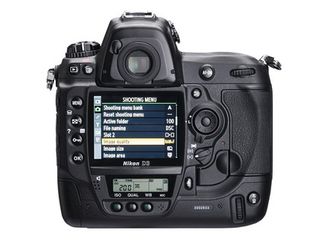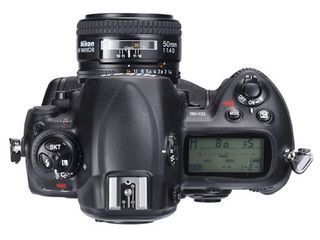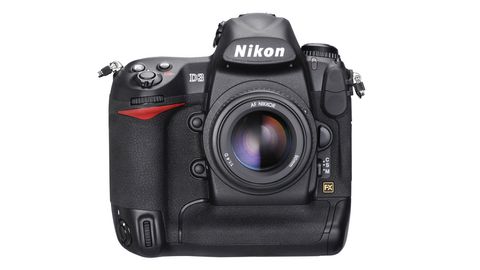TechRadar Verdict
Previously, Nikon's flagship pro SLR was the D2x, which, good though it was, never quite matched up to Canon's equivalent, the EOS 1Ds. The D3 changes everything. The Canon still has more pixels, but the Nikon is cheaper, faster and more versatile. Its image quality is stunning.
Pros
- +
All the features you could ask for
- +
Excellent performance
- +
Great build and handles well
- +
Good value considering its pedigree
Cons
- -
Less pixels than its rivals
Why you can trust TechRadar
Here's an interesting fact to mull over. The Canon EOS 1Ds Mk III will sell for £6,000, body only. For that, you can get a D3 body, one of the brand-new Nikkor 24-70mm f/2.8 N-series lenses and Nikon's fabulous 14-24mm N-series wide-angle zoom. Remember, the D3 is a full-frame SLR, so that 14mm zoom is so wide you'll be lucky to keep your ears out of the picture.
Both of these are professional lenses with the build and optical quality that goes with it. We were fortunate enough to get to try out the D3 and these two lenses for this review, and the combination is truly awesome.
The 1Ds Mk III has 21 million pixels. The D3 has 12 million pixels, which is not as many but still a lot. Some clients may demand 21-megapixel files, but how many? You have to weigh this against the D3's far lower cost (£2,500 lower) and certain other capabilities that the Canon doesn't have.
These include the fact that the 1Ds Mk III can shoot at 5fps, while the D3 shoots at 9fps. The 1Ds Mk III goes from ISO 100-1600, but the D3 goes from ISO 200-6400 (yes, 6400). Stuck with a bunch of APS-C format lenses from lesser cameras in the range?
If you've got a 1Ds Mk III, tough luck - you can't use Canon's EF-S lenses on this model. If you've got a D3, though, and you slot on one of your old DX lenses, the camera spots it straight away and switches automatically to a 'cropped' mode to give you 5-megapixel photos. It's not much, but it's a lot better than nothing, and handy for making long telephotos even longer, thanks to the 1.5x focal factor.
This is not an attempt to trash the 1Ds Mk III, but it's important to understand just what Nikon has achieved with with its new professional flagship camera. The Canon wins on resolution, and it's a no-brainer if you've already invested heavily in Canon gear. But what Nikon has produced is a camera good enough for West End fashion shoots and frantic goal-mouth action at 3pm on a sleet-soaked January afternoon.
Handling and controls

One of the things you're paying for with a professional camera is build quality, and the D3 doesn't disappoint. We've remarked on the new D300's cast-iron feel, and this camera is just the same. The finish, the fit of the panels, the feel of the controls - they're all first rate.
On the rear, you get the same 920,000-pixel LCD that appears on the D300, so the quality of the display is excellent. Below this is a 'tertiary' panel (there's a secondary panel on the top), which displays ISO, quality and white balance settings, with buttons underneath for changing them - the white balance icons are too small, though, and not so easy to see in bad light.
Memory cards slide in via a door in the back of a camera, which has a double-catch mechanism to prevent you opening it accidentally. Inside are two CF card slots - see the camera annotation for a description of how these work together.
The battery slides into the base of the camera, and according to the manual, the battery's good for 4,300 shots between charges. The camera comes with a dual charger so that you can top up your spare at the same time.
Despite its size, this is an easy camera to carry. The extra height means that you can get all your fingers round the grip, and even with one of Nikon's exotic new N-series lenses fitted, it's still wieldy. In typical Nikon style, the controls are arranged for ergonomic efficiency rather than instant recognition, but if you've just come straight from a D200 or D2x, you'll have no trouble. It would've been nice, though, if the different Picture Controls (Standard, Vivid and so on) had been easier to get at, as they're buried in the menus.
There were a couple of other minor operational issues too. Sometime during the test period the sound went off - presumably the wrong button was pressed or a menu setting was overlooked, but we never did find out how to get it back. And twice during lens changing the Focus Mode switch, which is right by the lens release button, was knocked from Single Shot to Continuous.
The effect of this is that the AF squares in the viewfinder don't light any more and the camera will shoot before focus has been achieved - you could spend a long time rooting through the manual before discovering the real explanation. While we're at it, it's worth mentioning the Active D-Lighting option. D-Lighting is Nikon's software technology for lightening shadows in shots that have already been taken.
In Active D-Lighting mode, the camera adjusts the exposure to capture highlight detail, and then applies the D-Lighting adjustment. It works quite well, too, but why bury this in the menus? It takes too long to get to for such a potentially useful tool, and yet it's not something you'd want to leave on continuously, either.
Image quality

Petty gripes aside, the D3 handles really, really well. It's surprisingly quiet for a full-frame camera when shooting at 9fps, too. But it's the image quality that really stands out. Interestingly, in side-by-side tests the D3 proves little sharper than the D300 at low ISOs, suggesting that the resolution is limited by the pixel count and that - hopefully - future, higher-resolution versions will come along which are better still.
But at higher ISOs, the D3 has a very clear advantage. Compared with its rivals, the D300 is exceptional at ISO 1600. The D3, though, just blows it away. In fact, at ISO 6400, the D3 is producing similar image quality to the D300 at ISO 1600. Truly remarkable.
Indeed, the D3 gives you more of everything that's so admirable in the D300. More colour, less noise, faster frame rates. It's a spectacularly good camera. So good, in fact, that we have to repeat our only caveat about the D300.
Good as the cheaper model is, we suspect you're always going to be wondering whether the D3 wouldn't have been the better professional buy.
The TechRadar hive mind. The Megazord. The Voltron. When our powers combine, we become 'TECHRADAR STAFF'. You'll usually see this author name when the entire team has collaborated on a project or an article, whether that's a run-down ranking of our favorite Marvel films, or a round-up of all the coolest things we've collectively seen at annual tech shows like CES and MWC. We are one.

